Bowen Song
SMART: Relation-Aware Learning of Geometric Representations for Knowledge Graphs
Jul 17, 2025Abstract:Knowledge graph representation learning approaches provide a mapping between symbolic knowledge in the form of triples in a knowledge graph (KG) and their feature vectors. Knowledge graph embedding (KGE) models often represent relations in a KG as geometric transformations. Most state-of-the-art (SOTA) KGE models are derived from elementary geometric transformations (EGTs), such as translation, scaling, rotation, and reflection, or their combinations. These geometric transformations enable the models to effectively preserve specific structural and relational patterns of the KG. However, the current use of EGTs by KGEs remains insufficient without considering relation-specific transformations. Although recent models attempted to address this problem by ensembling SOTA baseline models in different ways, only a single or composite version of geometric transformations are used by such baselines to represent all the relations. In this paper, we propose a framework that evaluates how well each relation fits with different geometric transformations. Based on this ranking, the model can: (1) assign the best-matching transformation to each relation, or (2) use majority voting to choose one transformation type to apply across all relations. That is, the model learns a single relation-specific EGT in low dimensional vector space through an attention mechanism. Furthermore, we use the correlation between relations and EGTs, which are learned in a low dimension, for relation embeddings in a high dimensional vector space. The effectiveness of our models is demonstrated through comprehensive evaluations on three benchmark KGs as well as a real-world financial KG, witnessing a performance comparable to leading models
Antithetic Noise in Diffusion Models
Jun 06, 2025Abstract:We initiate a systematic study of antithetic initial noise in diffusion models. Across unconditional models trained on diverse datasets, text-conditioned latent-diffusion models, and diffusion-posterior samplers, we find that pairing each initial noise with its negation consistently yields strongly negatively correlated samples. To explain this phenomenon, we combine experiments and theoretical analysis, leading to a symmetry conjecture that the learned score function is approximately affine antisymmetric (odd symmetry up to a constant shift), and provide evidence supporting it. Leveraging this negative correlation, we enable two applications: (1) enhancing image diversity in models like Stable Diffusion without quality loss, and (2) sharpening uncertainty quantification (e.g., up to 90% narrower confidence intervals) when estimating downstream statistics. Building on these gains, we extend the two-point pairing to a randomized quasi-Monte Carlo estimator, which further improves estimation accuracy. Our framework is training-free, model-agnostic, and adds no runtime overhead.
Divide-Then-Align: Honest Alignment based on the Knowledge Boundary of RAG
May 27, 2025Abstract:Large language models (LLMs) augmented with retrieval systems have significantly advanced natural language processing tasks by integrating external knowledge sources, enabling more accurate and contextually rich responses. To improve the robustness of such systems against noisy retrievals, Retrieval-Augmented Fine-Tuning (RAFT) has emerged as a widely adopted method. However, RAFT conditions models to generate answers even in the absence of reliable knowledge. This behavior undermines their reliability in high-stakes domains, where acknowledging uncertainty is critical. To address this issue, we propose Divide-Then-Align (DTA), a post-training approach designed to endow RAG systems with the ability to respond with "I don't know" when the query is out of the knowledge boundary of both the retrieved passages and the model's internal knowledge. DTA divides data samples into four knowledge quadrants and constructs tailored preference data for each quadrant, resulting in a curated dataset for Direct Preference Optimization (DPO). Experimental results on three benchmark datasets demonstrate that DTA effectively balances accuracy with appropriate abstention, enhancing the reliability and trustworthiness of retrieval-augmented systems.
CCS: Controllable and Constrained Sampling with Diffusion Models via Initial Noise Perturbation
Feb 07, 2025



Abstract:Diffusion models have emerged as powerful tools for generative tasks, producing high-quality outputs across diverse domains. However, how the generated data responds to the initial noise perturbation in diffusion models remains under-explored, which hinders understanding the controllability of the sampling process. In this work, we first observe an interesting phenomenon: the relationship between the change of generation outputs and the scale of initial noise perturbation is highly linear through the diffusion ODE sampling. Then we provide both theoretical and empirical study to justify this linearity property of this input-output (noise-generation data) relationship. Inspired by these new insights, we propose a novel Controllable and Constrained Sampling method (CCS) together with a new controller algorithm for diffusion models to sample with desired statistical properties while preserving good sample quality. We perform extensive experiments to compare our proposed sampling approach with other methods on both sampling controllability and sampled data quality. Results show that our CCS method achieves more precisely controlled sampling while maintaining superior sample quality and diversity.
What You See Is What Matters: A Novel Visual and Physics-Based Metric for Evaluating Video Generation Quality
Nov 20, 2024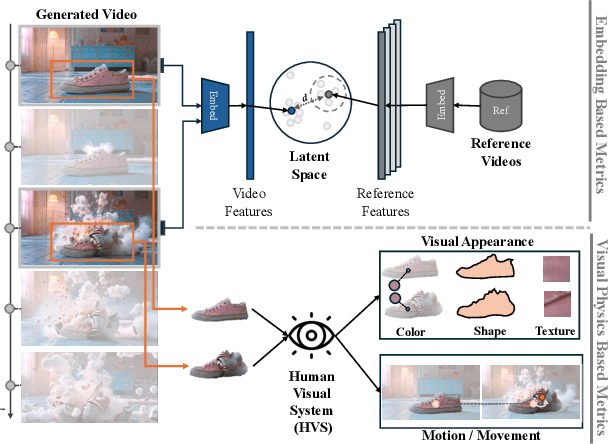
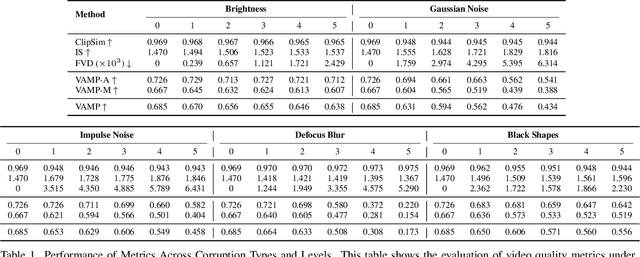
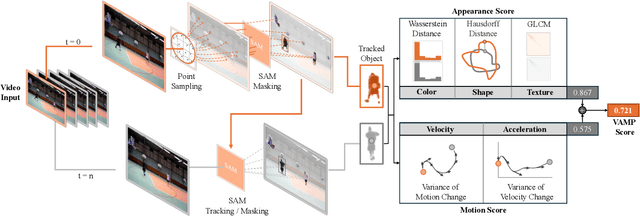

Abstract:As video generation models advance rapidly, assessing the quality of generated videos has become increasingly critical. Existing metrics, such as Fr\'echet Video Distance (FVD), Inception Score (IS), and ClipSim, measure quality primarily in latent space rather than from a human visual perspective, often overlooking key aspects like appearance and motion consistency to physical laws. In this paper, we propose a novel metric, VAMP (Visual Appearance and Motion Plausibility), that evaluates both the visual appearance and physical plausibility of generated videos. VAMP is composed of two main components: an appearance score, which assesses color, shape, and texture consistency across frames, and a motion score, which evaluates the realism of object movements. We validate VAMP through two experiments: corrupted video evaluation and generated video evaluation. In the corrupted video evaluation, we introduce various types of corruptions into real videos and measure the correlation between corruption severity and VAMP scores. In the generated video evaluation, we use state-of-the-art models to generate videos from carefully designed prompts and compare VAMP's performance to human evaluators' rankings. Our results demonstrate that VAMP effectively captures both visual fidelity and temporal consistency, offering a more comprehensive evaluation of video quality than traditional methods.
Patch-Based Diffusion Models Beat Whole-Image Models for Mismatched Distribution Inverse Problems
Oct 15, 2024



Abstract:Diffusion models have achieved excellent success in solving inverse problems due to their ability to learn strong image priors, but existing approaches require a large training dataset of images that should come from the same distribution as the test dataset. When the training and test distributions are mismatched, artifacts and hallucinations can occur in reconstructed images due to the incorrect priors. In this work, we systematically study out of distribution (OOD) problems where a known training distribution is first provided. We first study the setting where only a single measurement obtained from the unknown test distribution is available. Next we study the setting where a very small sample of data belonging to the test distribution is available, and our goal is still to reconstruct an image from a measurement that came from the test distribution. In both settings, we use a patch-based diffusion prior that learns the image distribution solely from patches. Furthermore, in the first setting, we include a self-supervised loss that helps the network output maintain consistency with the measurement. Extensive experiments show that in both settings, the patch-based method can obtain high quality image reconstructions that can outperform whole-image models and can compete with methods that have access to large in-distribution training datasets. Furthermore, we show how whole-image models are prone to memorization and overfitting, leading to artifacts in the reconstructions, while a patch-based model can resolve these issues.
Latent Space Disentanglement in Diffusion Transformers Enables Zero-shot Fine-grained Semantic Editing
Aug 23, 2024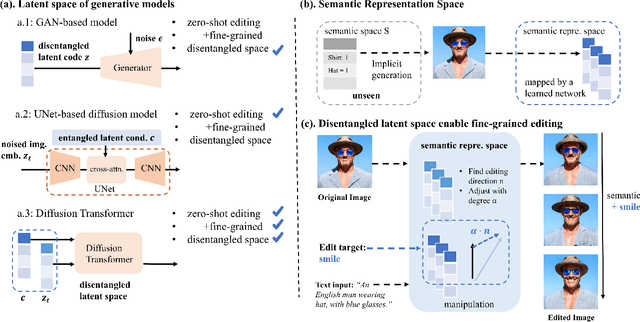

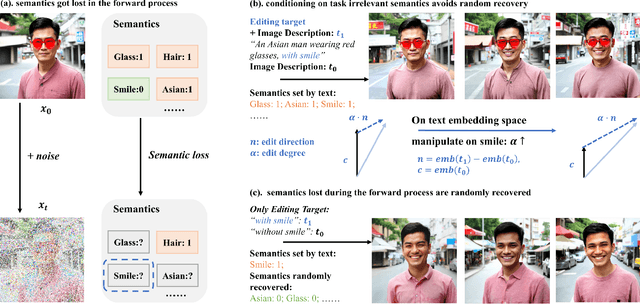

Abstract:Diffusion Transformers (DiTs) have achieved remarkable success in diverse and high-quality text-to-image(T2I) generation. However, how text and image latents individually and jointly contribute to the semantics of generated images, remain largely unexplored. Through our investigation of DiT's latent space, we have uncovered key findings that unlock the potential for zero-shot fine-grained semantic editing: (1) Both the text and image spaces in DiTs are inherently decomposable. (2) These spaces collectively form a disentangled semantic representation space, enabling precise and fine-grained semantic control. (3) Effective image editing requires the combined use of both text and image latent spaces. Leveraging these insights, we propose a simple and effective Extract-Manipulate-Sample (EMS) framework for zero-shot fine-grained image editing. Our approach first utilizes a multi-modal Large Language Model to convert input images and editing targets into text descriptions. We then linearly manipulate text embeddings based on the desired editing degree and employ constrained score distillation sampling to manipulate image embeddings. We quantify the disentanglement degree of the latent space of diffusion models by proposing a new metric. To evaluate fine-grained editing performance, we introduce a comprehensive benchmark incorporating both human annotations, manual evaluation, and automatic metrics. We have conducted extensive experimental results and in-depth analysis to thoroughly uncover the semantic disentanglement properties of the diffusion transformer, as well as the effectiveness of our proposed method. Our annotated benchmark dataset is publicly available at https://anonymous.com/anonymous/EMS-Benchmark, facilitating reproducible research in this domain.
Cycle-Configuration: A Novel Graph-theoretic Descriptor Set for Molecular Inference
Aug 09, 2024Abstract:In this paper, we propose a novel family of descriptors of chemical graphs, named cycle-configuration (CC), that can be used in the standard "two-layered (2L) model" of mol-infer, a molecular inference framework based on mixed integer linear programming (MILP) and machine learning (ML). Proposed descriptors capture the notion of ortho/meta/para patterns that appear in aromatic rings, which has been impossible in the framework so far. Computational experiments show that, when the new descriptors are supplied, we can construct prediction functions of similar or better performance for all of the 27 tested chemical properties. We also provide an MILP formulation that asks for a chemical graph with desired properties under the 2L model with CC descriptors (2L+CC model). We show that a chemical graph with up to 50 non-hydrogen vertices can be inferred in a practical time.
CoSIGN: Few-Step Guidance of ConSIstency Model to Solve General INverse Problems
Jul 17, 2024Abstract:Diffusion models have been demonstrated as strong priors for solving general inverse problems. Most existing Diffusion model-based Inverse Problem Solvers (DIS) employ a plug-and-play approach to guide the sampling trajectory with either projections or gradients. Though effective, these methods generally necessitate hundreds of sampling steps, posing a dilemma between inference time and reconstruction quality. In this work, we try to push the boundary of inference steps to 1-2 NFEs while still maintaining high reconstruction quality. To achieve this, we propose to leverage a pretrained distillation of diffusion model, namely consistency model, as the data prior. The key to achieving few-step guidance is to enforce two types of constraints during the sampling process of the consistency model: soft measurement constraint with ControlNet and hard measurement constraint via optimization. Supporting both single-step reconstruction and multistep refinement, the proposed framework further provides a way to trade image quality with additional computational cost. Within comparable NFEs, our method achieves new state-of-the-art in diffusion-based inverse problem solving, showcasing the significant potential of employing prior-based inverse problem solvers for real-world applications. Code is available at: https://github.com/BioMed-AI-Lab-U-Michgan/cosign.
DiffusionBlend: Learning 3D Image Prior through Position-aware Diffusion Score Blending for 3D Computed Tomography Reconstruction
Jun 14, 2024

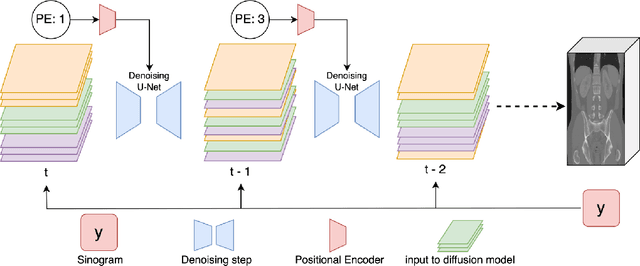

Abstract:Diffusion models face significant challenges when employed for large-scale medical image reconstruction in real practice such as 3D Computed Tomography (CT). Due to the demanding memory, time, and data requirements, it is difficult to train a diffusion model directly on the entire volume of high-dimensional data to obtain an efficient 3D diffusion prior. Existing works utilizing diffusion priors on single 2D image slice with hand-crafted cross-slice regularization would sacrifice the z-axis consistency, which results in severe artifacts along the z-axis. In this work, we propose a novel framework that enables learning the 3D image prior through position-aware 3D-patch diffusion score blending for reconstructing large-scale 3D medical images. To the best of our knowledge, we are the first to utilize a 3D-patch diffusion prior for 3D medical image reconstruction. Extensive experiments on sparse view and limited angle CT reconstruction show that our DiffusionBlend method significantly outperforms previous methods and achieves state-of-the-art performance on real-world CT reconstruction problems with high-dimensional 3D image (i.e., $256 \times 256 \times 500$). Our algorithm also comes with better or comparable computational efficiency than previous state-of-the-art methods.
 Add to Chrome
Add to Chrome Add to Firefox
Add to Firefox Add to Edge
Add to Edge